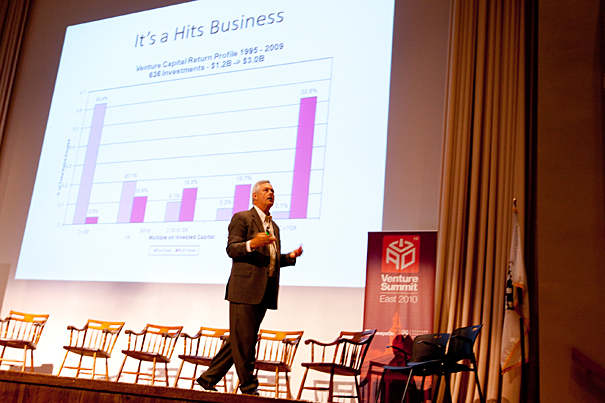
Professor Bill Sahlman of Harvard Business School delivered the keynote address at a three-day conference on venture capital and investing at the Harvard Business School.
Rose Lincoln/Harvard Staff Photographer
Meeting in the middle
At HBS, investors and executives probe promising new fields
Bring the brains and the bucks together.
That was the pragmatic goal behind “Venture Summit East 2010,” a conference held June 21 to 23 at Harvard Business School (HBS). Institutional investors, venture capitalists, entrepreneurs, investment bankers, and research analysts gathered to explore economic, political, and technological trends in global investment.
In one panel, venture capitalists and CEOs explored the sometimes delicate dynamic between the two powerhouse economic fields. They asked: How can investors and inventors best work together to get smart ideas off the ground and into the public realm?
Egos and attitudes play an important role, the panelists said, along with the ability to admit strengths and weaknesses.
“Too often, I think entrepreneurs and venture capitalists get stuck in a cycle of dysfunction … to promote their own egos or cover up their weaknesses,” said panelist Andy Palmer, former CEO and co-founder of Vertica Systems, which produces analytic database management systems. “The most successful companies are the ones that strip away all of that and focus on the transparency.”
During a panel called “Can VCs and Entrepreneurs Solve the World’s
Problems?” Greylock Partners chairman Henry McCance described his work to bring a venture capital mindset to medical research by founding the Cure Alzheimer’s Fund. Eliminating the typical lengthy research grant process and building an all-star team, he said, sped up discovery. In less than three years, said McCance, the fund’s researchers identified about 70 gene variants that confer risk or help to protect against Alzheimer’s disease.
Consider venture philanthropy early in a career, he urged. McCance predicted that a venture capitalist approach will crack the next generation of global problems in health care, energy, and education.
In a keynote address, Bill Sahlman, the Dimitri V. D’Arbeloff-MBA Class of 1955 Professor of Business Administration and senior associate dean for external relations, explored the high risk and reward aspects of venture capital. He examined a chart detailing 636 venture capital investments from 1995 to 2009 and noted that 62 percent of the $1.2 billion invested during that period was “flush, gone, zero, nada.”
In the same time frame, just over 3 percent of the dollars invested turned into 53 percent of the “ultimate value of the portfolio,” he said.
Sahlman’s chart reflected an inherent venture capital conundrum: Profits are the goal, but more often than not investments fail to produce hefty returns. But regardless of the bottom line, he argued, such investment is critical in spurring important innovation in areas such as life and material sciences and alternative fuels.
“Venture capital’s losses,” said Sahlman, “are society’s gains.”
The event, co-sponsored by HBS and KPMG, a global network of professional firms providing audit, tax, and advisory services, examined a range of topics, including expanding investment opportunities in digital media, identifying the keys to strong management teams, developing mobile technology and biofuels, and understanding the impact of globalization.
A panel of health care investment executives and entrepreneurs said technology will play an increasingly important role in streamlining industry processes, including collecting patient data.
Doctors “feel like they are data input clerks,” said Rob Cosinuke, senior vice president and chief marketing officer of athenahealth Inc., a company that has created a Web-based application to assist practice management, billing services, and medical records management. “If you can come up with applications that take doctors out of being keystroke monkeys and into being doctors again, the small group and the group practices are going to buy it like crazy.”
Another panelist said one health care avenue worthy of investment has nothing to do with medical care and everything to do with lifestyle changes. “I would encourage everybody to blow up the paradigm in their minds that health care is only about hospitals and doctors,” said David Jones Jr., managing director of the venture capital firm Chrysalis Ventures.
Jones said his company has invested heavily in trends that deliver “incentives, information, and monitoring” services and “all kinds of things to do with health but not medical care.”
The life sciences are another field attracting attention and funding, according to a panel of investors and entrepreneurs. Despite the slowly rebounding economy, they said, there is money available for that sector.
“There are plenty of opportunities for the right ideas to get funded,” said Peter Barrett from Atlas Venture. The firm’s portfolio includes a significant number of life sciences businesses in the United States and Europe.
The mix of inventors and investors detailed what they consider some of the most promising areas in the field. One was the use of biotechnology to increase the production and capacity of coal-bed methane wells.
Another was a biological breakthrough by biologist Craig Venter and his biotechnology company Synthetic Genomics. Juan Enriquez, managing director of Excel Venture Management, which backs Venter’s firm, described how the company works to combine computer code, robots, and the largest organic molecule humans have ever built. Enriquez admitted it was not creating “life from scratch.” But he called it “the equivalent of walking down to your Volkswagen with a Lexus engine, sticking your Lexus engine into the Volkswagen and having every part of that car become a Lexus by the next morning. … That will be something that will have an impact across a whole series of different industries.”
Panel moderator Robert Noonan, a partner at KPMG, summed up, saying, “There’s a lot of exciting tech still out there, a lot of good ideas that deserve funding, and a lot of hope for the future.”





